-
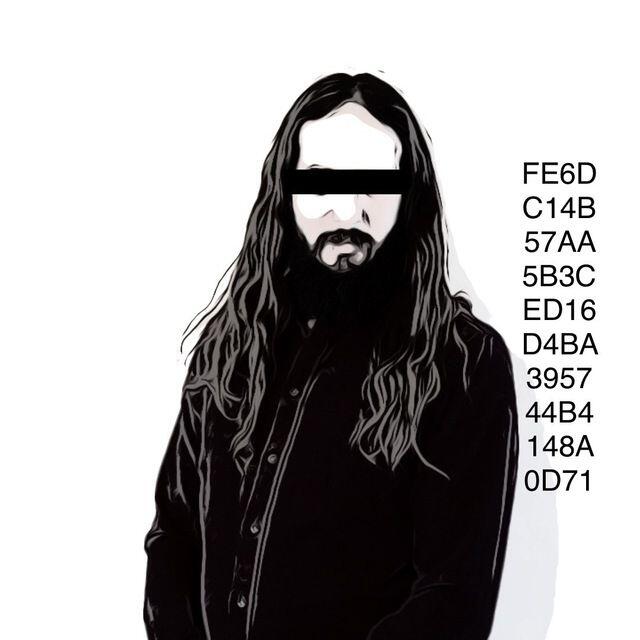 @ econoalchemist
2025-03-20 23:50:37
@ econoalchemist
2025-03-20 23:50:37
Introduction:
Welcome to the third newsletter produced by The 256 Foundation! February was an interesting month with a range of events from the mempool clearing to a new ASIC producer entering the chip arena. This month’s newsletter covers the latest news, mining industry developments, progress updates on grant projects, actionable advice on air cooling vs. liquid cooling, and the current state of the Bitcoin network.
Definitions:
MA = Moving Average
Eh/s = Exahash per second
Ph/s = Petahash per second
Th/s = Terahash per second
T = Trillion
J/Th = Joules per Terahash
$ = US Dollar
vB = Virtual Byte
PSU = Power Supply Unit
News:
February 1st was the 10th anniversary of the Samourai Wallet project and unfortunately an occasion marked with uncertainty instead of celebration for the developers. On April 24th, 2024 the developers were indicted, raided, and arrested in a multi-national coordinated effort led by the US Department of Justice out of the Southern District of New York (“SDNY”) headquarters. The charges brought against them include conspiracy to operate an unlicensed money transmitter business and conspiracy to launder money, which caught the entire industry off guard in light of the 2013/19 FinCEN guidance explicitly stating that “un-hosted wallet providers” are not considered money transmitters [4.2.1] nor are “Anonymizing software providers” [4.5.1(b)]. The precedence set in this case can have wide-spread consequences for anyone involved with Bitcoin, be it wallet developers, node operators, or miners. You can make a tax-deducatible contribution to support the Samourai Wallet legal defense fund here.
On February 6th France moved to make cryptocurrency transactions using mixers presumed illicit unless proven otherwise. A startling development and shotgun approach that turns swaths of the population into criminals without good cause.
On February 7th Alexey Pertsev was released from prison under the conditions of house arrest and electronic monitoring. Alexey is one of the Tornado Cash developers and was previously sentenced to 5-years in prison and is currently appealing that conviction. The Tornado Cash developers did nothing wrong and should not face prison sentences for writing open-source code deployed as a smart contract on the Ethereum blockchain, once deployed the developers had no control over how their neutral software was used.
On February 9th @Skot9000 went on The Home Mining Podcast to talk about the story of the Bitaxe from concept to reality.
On February 11th @Skot9000 and @econoalchemist went on The Mining Pod to discuss The 256 Foundation’s telehash event.
On February 14th @Skot9000 and @econoalchemist went on The Bitcoin Way podcast to discuss The 256 Foundation’s mission to dismantle the proprietary mining empire and reveal the Ember One.
On February 21st Apple removed advanced data protection tool for United Kingdom customers following the UK government’s request for an unrestricted backdoor to Apple user’s iCloud information globally. Every government trends towards tyranny and this is an alarming move by the UK government which makes the trajectory crystal clear, the globalists want you to have no privacy nor financial freedom.
On February 21st @SpaceDenver kicked off the Heatpunk Mining Summit, a two day event in Denver, CO focused on Bitcoin mining heat reuse applications. There was a range of participants from Do-it-Yourselfers to plumbers. @Schnitzel wrote up a great recap of the event.
Mining Industry Developments:
The development will not stop until Bitcoin mining is free and open. Innovators didn’t let off the gas in February, here are seven note-worthy events:
0) Some thought this day would never come, others saw it coming from a mile away but on February 1st the mempool cleared.
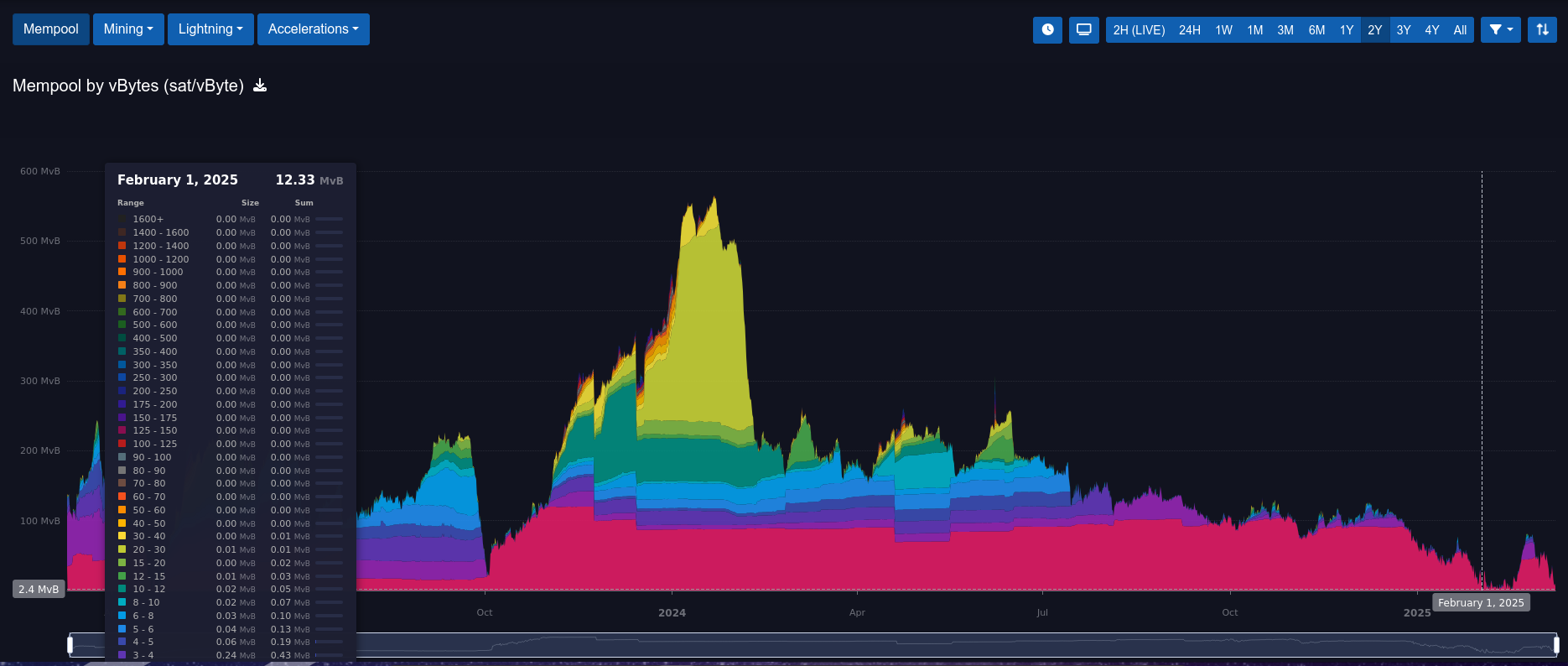 [IMG-000] Mempool Clearing
[IMG-000] Mempool ClearingThis is significant for a number of reasons: on-chain transactions were able to be included in the next block for 1 sat/vB which means on-chain enjoyooors could get both speed and economy when sending bitcoin. But this means the percentage of mining rewards from transaction fees were low. A lack of on-chain transactions can indicate that the network is getting little use and it can be further extrapolated that a network with little use will inevitably have little value leading to less interest, less development, less adoption, less miners, less security, etc. The best way to mitigate such concerns is to take self-custody of your bitcoin. Trusted third parties like centralized exchanges and derivative products like paper IOUs can move balances between accounts off-chain without transferring ownership of the underlying bitcoin itself. The next best step is to actually use your bitcoin to buy things.
1) On February 2nd the Nerd OCTAXE makes a splash, racking up 10.8 Th/s with 8 BM1370 ASICs on a 160W+ PSU.
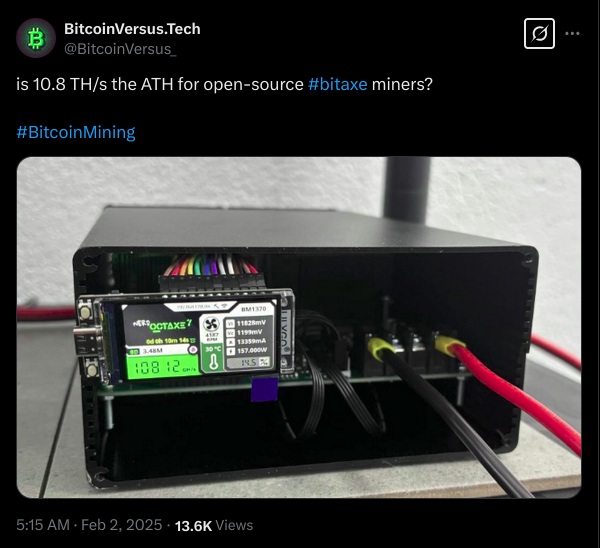 [IMG-001] Nerd OCTAXE Reveal
[IMG-001] Nerd OCTAXE RevealThe Nerd OCTAXE is fully open-source using the CERN-OHL-S license. The display is a NerdAxe/NerdMiner unit and the whole system is standalone meaning that no Raspberry Pi or other computer is needed. The GitHub repo has detailed build instructions and all the details about the project can be found there.
2) On February 4th @OrangeSurfBTC publishes the Mempool.space Block Size Report examining the evolution of Bitcoin block sizes from block height 0 through block height 881866.
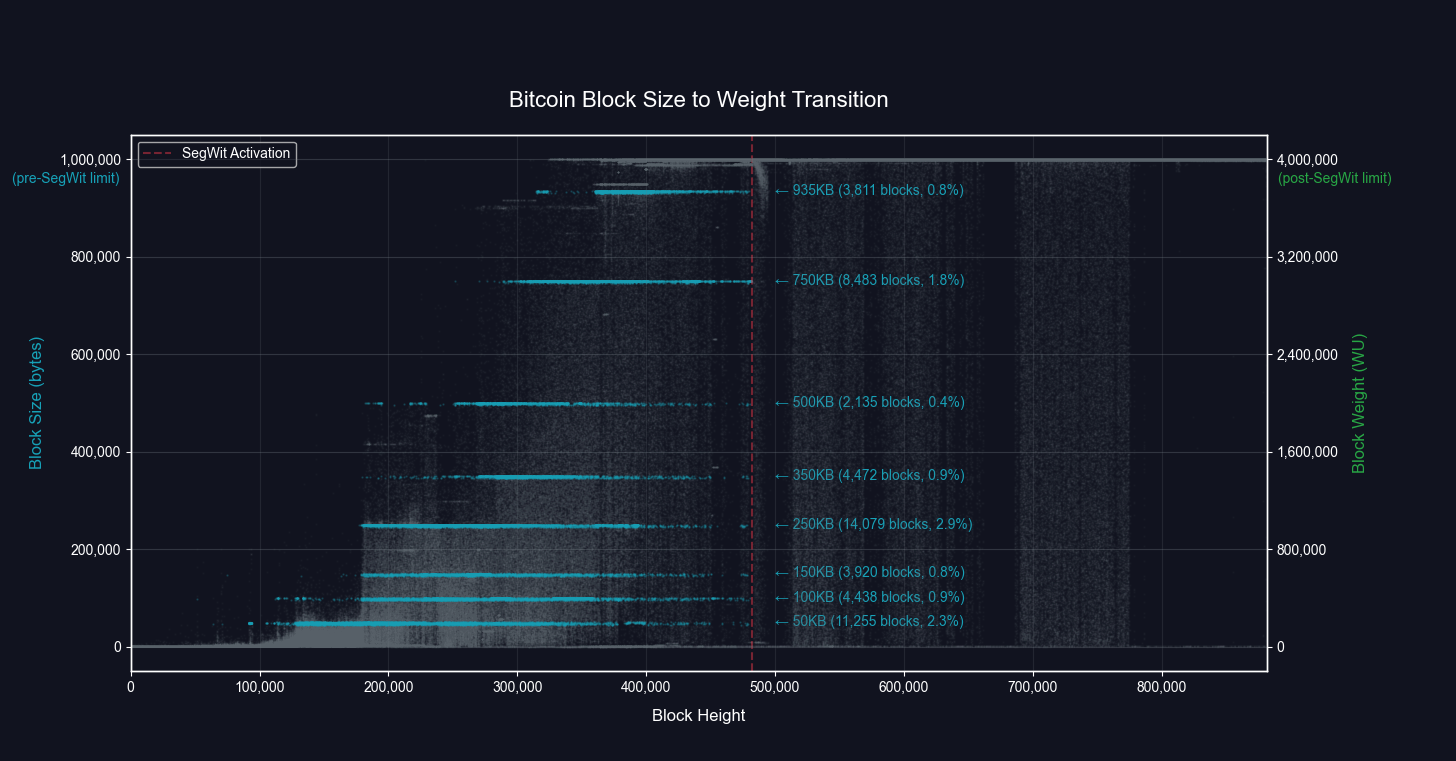 [IMG-002] Block Size to Weight Graph from OrangeSurf
[IMG-002] Block Size to Weight Graph from OrangeSurfThis report offers a deep technical dive into how BitcoinCore default settings, miner-selected configuration values, transaction backlog, SegWit, and inscriptions all affected block sizes and space utilization.
The graph above for example, displays horizontal bands at varying data sizes that correspond to default BitcoinCore settings; indicating that many miners were running the default BitcoinCore settings.
There are great explanations and technical analysis in this report. Be sure to check it out for an in depth understanding of Bitcoin block size trends.
3) On February 5th Mempool.space implements Stratum Jobs visualizer:
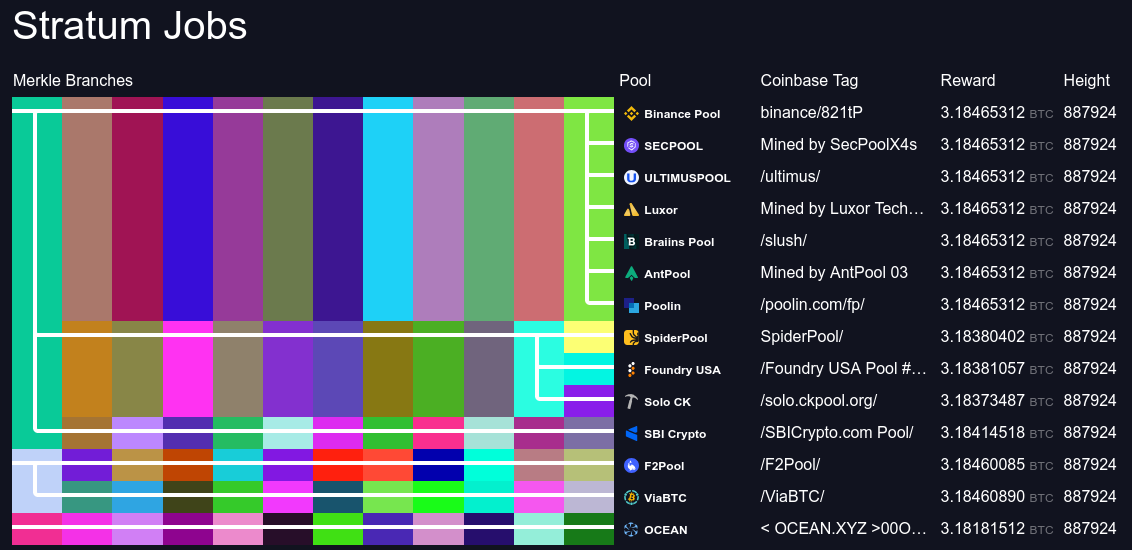 [IMG-003] Mempool.space Stratum Jobs
[IMG-003] Mempool.space Stratum JobsThis is a visualization tool similar to Boerst’s Stratum.work that shows which pools are using the same block templates which offers insight into miner centralization. The more of these visualization tools people have, the more informed everyone will be. Miner centralization can have several negative effects on the Bitcoin network including censorship attempts.
In the image above for example, it can be observed that Binance Pool, SEC Pool, Ultimus Pool, Luxor, Braiins, and Poolin are all using Antpool’s block template down to the 12th Merkle branch.
The ability for miners to generate their own block templates is an important step forward in the fight for keeping Bitcoin mining decentralized. Currently, some available options to achieve this are by self-hosting Public Pool or CK Pool, which the FutureBit Apollo’s do out of the box and is the setup used to solo mine block 881423 during The 256 Foundation’s Telehash; or self-hosting OCEAN’s DATUM.
4) On February 11th @RohEisenHammer revealed a Bitaxe Gamma that produces increased hashrate with the open-source BreaktheFiat Cooling System 60mm v1.
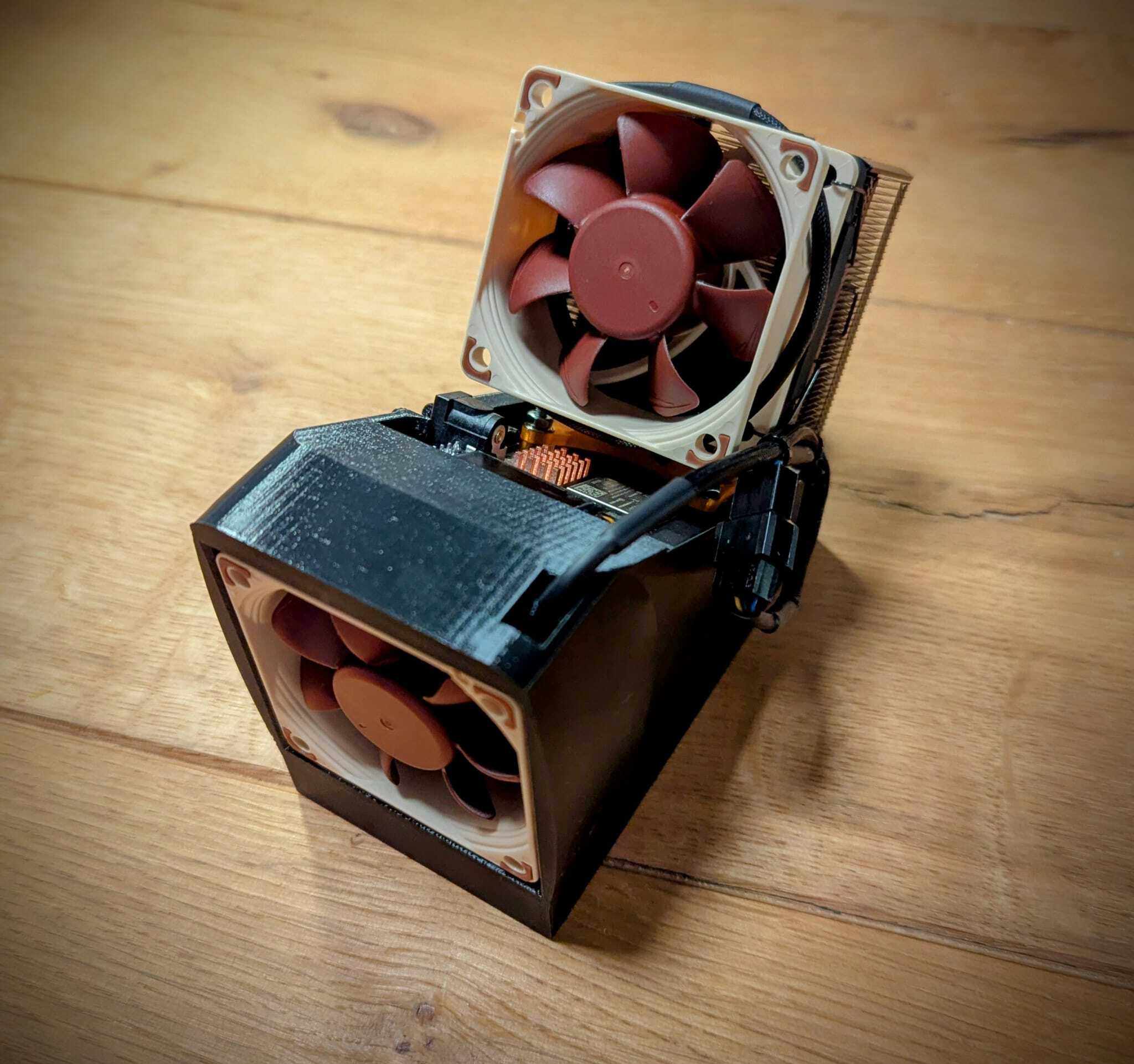 [IMG-004] BreaktheFiat Cooling System
[IMG-004] BreaktheFiat Cooling SystemThis innovative cooling system cools both sides of the Bitaxe allowing the user to over-clock the device more.
5) On February 27th Braiins announced they have their own Bitcoin mining ASIC test chip. The test chip has been in development for 2.5 years and although the specific efficiency is not yet disclosed, this demonstrates that there is an increasing interest from more participants to make their own Bitcoin mining ASICs, departing from a dependency on Bitmain.
6) On February 28th Braiins committed to open-sourcing their Control Board, supporting software, and some extras. This is a step forward in making Bitcoin mining free and open. The control board is designed to replace stock Antminer control boards.
The software being released with the control board includes an OpenWrt distribution, Linux support for mining peripherals, along with source code for the basic board firmware, U-boot, Linux kernel, and OpenWrt. The firmware does not have the mining component built in but all the tooling is there for users to develop their own mining firmware. Braiins OS is not included in the release.
Extras include a guide on building a fully functional mining setup with all the provided tools. Users can even take the Braiins firmware binaries and the provided tools to compile their own image to flash onto the control board. A Nix shell for the build environment is also included.
The software will be released under the GPLv3 open-source license and which open-source license the hardware portion will be released under is still under consideration. But everything will be openly available by the end of March so keep an eye out for further announcements.
Grant Project Updates
In February The 256 Foundation reviewed all the grant applications, thank you to everyone who showed interest in working on the 5 projects up for grabs. Interviews were scheduled for qualified candidates and one lead developer was chosen for each project. Currently negotiations are taking place to work out timelines, deliverables, and budgets for each project. The projects will be officially kicked off on April 5th, 2025 and the lead developers for each project will be announced at that time.
The five projects are: Ember One v01, a ~100 Watt standardized hashboard designed with the Intel BZM2 ASIC. The Ember One v00 with the Bitmain ASIC is nearing completion and the fully validated design will be released by the end of April, 2025. The GitHub repo is now open to the public and anyone can start taking a look now.
Mujina Mining Firmware, a Linux based mining firmware application with support for multiple drivers so it can be used with Ember One v00 with the Bitmain ASIC or Ember One v01 with the Intel ASIC and will implement Stratum v2 client support.
Libre Board, the control board for the Ember One built to support high power compute modules, MIPI touchscreen display port, NVME expansion to run a full node, Raspberry Pi 40-pin header, and much more.
Hydra Pool, the stratum server application that will run on the Ember One mining system, features support for Stratum v2, solo mining mode or alternative payout model selection, and a user friendly dashboard to view pool stats.
Block Watcher, a Bitcoin mining insights application built to run on the Ember One mining system using the self-hosted node for blockchain data. Provides comprehensive visualization tools to help inform the user.
Actionable Advice:
Summer is coming! Time to take into consideration different cooling techniques for your Bitcoin miners. Do you stick with the default air cooled approach or is it worth it to spend the extra capital on a liquid cooled operation? Who better to hear from than two industry titans, Mike Hamilton former Chief Technical Officer & Chief Research Officer at Griid prior to the CleanSpark acquisition and Kevin Zhang Executive at Foundry Services. The following is a transcript of our panel discussion during NEMS25 hosted by yours truly.
Eco: Welcome you guys. So the title of this panel is “ASICs Wet or Dry” and both of you have a ton of mining experience. So why don't we do some brief intros, tell us who you are, what you've been up to and then we'll get into it.
Mike: Sure. Mike Hamilton, I was the CTO and Chief Research Officer for Grid, acquired by CleanSpark. I've since left and I'm finding out what's next, probably some 256 foundation stuff.
Rod: Let's go! (audience applause)
Mike: Because once you mind a block, everybody wants on board. So yeah, I was a chip designer, did some network security for a long time and then full-time mining since 2019.
Kevin: Good stuff guys. I'm Kevin Zhang, I'm not Matt, so if you came for the Giga talk, I'm sorry. With the new administration in office, it's okay to be a cis white male again, so I was going to give it a shot. (audience laughter)
Jokes aside, I've been a Bitcoin mining in the US for some time now and lately I've been at Foundry last four and a half years. I think everyone knows who we are, especially recently mine 7 blocks in a row. Surprised, no one commented, we actually mined eight at one time in a row. So I guess everyone's asleep, but we'll leave that for another discussion.
Eco: Wait, wait, wait, hold on. When was the eight blocks? Was that like years ago?
Kevin: No, it was like three months ago.
Eco: No kidding?
Kevin: Yeah.
Eco: Wow. Kevin: But no one also comments that the fact that we are actually unlucky for that same 24-hour period. So we actually lost money on that day. But I digress.
My background's always been in Bitcoin mining and especially I remember back in the day when immersion mining is first coming out, everyone's very skeptical. Now people are on board with immersion mining and now they're skeptical of hydro mining.
So it's interesting to see how these technologies come about and the adoption curve and how long it actually takes.
But I'm excited to be talking about this topic. It's going to be a lot of fun guys.
Eco: Yeah. So you mentioned something interesting there. So you mentioned both hydro and immersion. So this isn't just ASICs wet versus dry as if as though there's one version of wet.
There's actually multiple different types. So we've got immersion. Do you do anything with two phase immersion?
Because I've seen some of that recently where you're like dipping the ASIC in the solvent and it's boiling off.
If you've got any experience there or with hydro, let's get right into it. Which kind of wet are we talking about here?
Kevin: All right. So maybe we can take a step back and introduce all the different variants of types of mining, right? So the one I think everyone's most familiar with is air-cooled mining. And that's simply you're taking cold air and pushing it through the miner and exhausting hot air on the other side.
When it comes to liquid cooling, now there's many different types. In the beginning, I think one of the more popular ones was immersion, which is what you're actually is you're taking a miner, sometimes converting an air core miner. Sometimes it's an immersion specifically designed equipment.
You're dipping it and submerging it into dielectric fluid and using the fluid to kind of transmit the heat off the chips. And that's kind of you're actually taking the fluids and you're touching that to the chips itself. Then there is Novak 3M, which is the most popular use case for two-phase immersion. Two-phase is a fancy way of saying the state of the liquid or using the cool something is changing. So what you're doing is you're taking a fluid, you're using that that spurs the heat. And the heat dispersion happens when you're changing it from a fluid of solid state into a gas.
So it's super cool technology. The downside of it is to date it's still been very, very expensive. And the last form of cooling is hydro. It's another form of liquid cooling. And that's where you're actually running standard water or treated water through tubes that go across the boards on the miners to dissipate the heat.
Eco: Which one of those methods or is it all three? Do you got a mix in your operations that you use?
Kevin: So we've tested all of them. The only one we don't do at scale is the two-phase, which is the Novak 3M solution.
Eco; And why is that?
Kevin: It's been cost prohibitive to date. And the same has been true to immersion in hydro when it first came out. So probably it'll take some time for it to come to be more economical and more cost-efficient.
Eco: So let's break this down a little bit further. So if I wanted to cool my miners with immersion, can I just take the miner and drop it in a bath of dielectric oil?
Mike: I mean, kind of, like most answers about anything, it depends. But really you have to take off the fans, if you're taking an air-cooled machine. And then there's sometimes there's some weirdness with the power supplies. And some of you may actually take the power supply fans off.
Or in the case of one of my sites, we put popsicle sticks in there to keep the fans from spinning. So they wouldn't recycle the fluid. But there is usually some amount of work to prepare them for actual full immersion.
Eco: So it sounds like there's some labor involved and some modifications needed. Are the efficiency gains from this different type of cooling method, do they offset the extra labor that goes into setting it up?
Kevin: So yes and no. I think before we kind of get into overgeneralization of like, will this improve your economics or not? I think you have to look at the specific site that you're working with.
If you can run air-cooled air, if it's dry, if it's cool, you may not need to over-complicate things but going into liquid cooling or getting too fancy and cute with your infrastructure.
Now, if you're in a very hot climate and heat is everywhere, there's no cold air to draw into your site, maybe that's when you start looking at these things. No different than if it's way too humid or way too wet outside. You can't use the outside air or damaged machines. That's when you look at liquid type cooling.
And then to answer your question, it depends on what you paid for your miner, obviously, right? And the modifications needed.
Nowadays, immersion and hydro are popular enough that the manufacturers like Bitmain, MicroBT, they're making units out of the box that are designed for those use cases. Back in the day, you have to modify air-cooled miner, you have to remove the fans, you have to Jerry-rig it, like Michael's talking about it. And you also have to exploit the miner and change the firmware.
So you're voiding the warranty both physically and on the software layer as well.
So I think now with a lot of the new manufacturer support, it's been a lot more capital-efficient and a lot more streamlined.
And I think there was a gentleman here yesterday asking about what's my miner firmware. And I think that's been like a long time meme when it comes to brains and others. There isn't much optimization for air cooling, firmware for MicroBT, but where the optimization comes in is on the immersion side, where really your only limitation is your power supply. You can crank up the overclocking, the frequency and the voltage, so much more on the chips, as long as the power supply can support it and you have good flow of your liquids to dissipate the heat.
Eco: So you bring up an interesting point. It's like kind of site-specific will determine what sort of cooling method you want to apply, right? And just out of curiosity, and if you guys can speak about it, like how many sites have you all operated and what kind of geographic locations were they in and out of those, which cooling methods were you employing and why?
Mike: Yeah, and I think I've set up several sites in various locations. So it's sort of North Texas area, actually doing a gas well site. We chose immersion partially because it's right next to a multi-million dollar house home neighborhood and there's this oil well sitting behind it. And so we opted for immersion. It's a little bit hotter. It's a little bit dusty there at the well.
Incidentally, we also generate onsite, which is not quieter than the actual miners themselves, but that was a lot to do with the dust and the temperature.
And then other sites, it would be lots of Tennessee TVA sites where it's relatively cool. Now it does get hot. It can get pretty hot during the summers. So we did lots of air-cooled.
We did a little bit of immersion, a single phase full immersion, mostly from a proof of concept. Really, when you're trying to build quickly and inexpensively air-cooled, given the right environment is generally cheaper with some other trade-offs. So I've done a little bit of both.
Eco: Is it easier to keep the dust out of the mining equipment using immersion?
Mike: Yes. I mean, that is one of the benefits, at least in the single phase immersion, like the tank outside. The machine is basically protected. There's no moisture. There's no air.
So from that perspective, it can be good for the actual machine that is not getting on to that exposure. But at the same time, the fluid can create other problems with plastics and hardening. There's other issues.
Eco: How about you, Kevin? What kind of sites have you set up and what kind of methods did you employ?
Kevin: Sure. So I think my mining career, which started about 10 years ago, it predated a lot of the economics coming down of the liquid cooling. So for me, it was a lot of air-cooled sites. And if you look at it historically, somewhere to my sites, I was always building them more the climate was cooler and drier.
But with the new innovation and the cost coming down on liquid cooling, it's allowed for new regions to break into mining, in particular leveraging hydro or immersion.
In the past, I was always monitoring in Montana or northern China, where there's a lot of coal power, where it's cool climates.
Nowadays, you have mining in the Middle East. They're huge fans of hydro mining over there. So we were out in Oman recently. We partnered with some of those sites that were mining our pool over in Dubai.
And also now you have South America, where sometimes it's way too humid. They're able to mine. Or if they're too close to the equator, it could be too hot and too humid. They can mine because now they're using immersion down there as well.
So just seeing kind of the shifts geographically, all these new locations have been unlocked. Now that the outside climate's no longer a concern, that's been pretty exciting to see.
Mike: Yeah, and I think the noise issue is also a thing too. There was lots of sites that we looked at in many different situations where there's homes close, there's businesses close.
In one case, there was a school literally a few hundred feet away. And just while dry coolers and the other infrastructure aren't necessarily quiet, it's a different frequency of the high pitched fans of air cooled mining can be distracting.
Eco: Yeah, you bring up an interesting point. So if you're running an immersion system, you don't have these fans that are just passing millions of cubic feet of air a day through the ASICs, right? And those fans are what create all the noise and are screaming. And that's what people hear. So were you making those decisions preemptively? Like maybe based on some of the backlash we've seen from that site that Mara runs, that they got a bunch of noise complaints. Were those preemptive decisions or were you doing that because somebody complained to you?
Mike: I mean, we did. There was some public news around a site that we had that had gotten some noise complaints and it turned into a bigger thing. And so we're definitely more careful because if you have an air cooled site, trying to quiet an air cooled site, post build is very difficult. You know, hay bales or sound walls. And then it starts to get unsightly. So designing for the sound is very important from the beginning.
Eco: Right, because you've kind of built this whole setup around these miners, right? And now you're getting noise complaints.
Mike: And you design the site for airflow. Well, now you have a 20 foot wall to help with the sound. But now you've restricted airflow into your containers and it creates all sorts of other problems. And the reality was with these big, you know, the dry cooler manufacturers, you know, we got, we did some proof of concepts with one of the manufacturers. We're using 12 foot fan on the dry cooler. So it's still moving effectively the same amount of air as all the small fans. But it's a much lower rotation, you know, lower frequency noise. And so it's much less or much more pleasant than the cyber hornets.
Eco: Yeah. What other environmental considerations are there? Like if you've got tanks full of immersion fluid, is there special considerations, secondary containment systems, dams, barriers to contain spills? Like, are there any considerations along those lines that go into place?
Kevin: So historically there have been, but I think with the new improvements, there's like two types of designs. There's a kind of open loop system where kind of bring water in, bring liquids in that aren't in your closed solution. And they're just closed loop, which is yours recycling the same kind of fluids over and over again.
So more and more nowadays you have closed loop systems or you have like reserves of water that you're bringing in. You're not drawing from a lake, you're not drawing from a new water source. That has led to a lot more, a lot less backlash where it's like there's really no environmental concerns with that. And when we talk about kind of these environmental concerns, I always get some PTSD because I was at Greenwich generation, which was the very first power plant to ever mind Bitcoin in the States. And federally regulated behind the meter, I think it was such a special project for me to be on.
But then the push back from the environmentalists, we're just, there's no logic and rhyme or reason. It's like our fans, I could totally see the argument if we're disturbing the nearby neighbors, but they're coming in and protesting and saying we're scaring the way the killer whales in the Atlantic Ocean. And we're off of a lake in upstate New York, right?
So I think now you're kind of taking away that side of the argument, whether it's logical or not. And I think that just makes it a much more buttoned up case when no one has any, it's more proof when it comes to operating without any of these environmental concerns.
Eco: That brings to mind the saying that it takes exponential more effort to refute bullshit than it does to just say the bullshit, right?
Kevin: Absolutely.
Eco: Did you have to bring counter evidence to the table and say that and demonstrate no, we're not disturbing the whales?
Kevin: Yeah. It's like you have all these measurements, you have decibel counters, this and that, like you're kind of property lines. It doesn't matter. It doesn't just come up with a new excuse, right? A new complaint. Yeah.
Mike: I mean, we had some city council meetings and you get people, you know, of various generations, but of particular generations that are very set in their beliefs, they hear one thing. At one site we were looking at and there was a guy that had sort of like a rescue animal zoo. And he was saying that like his, his animals were going to stop reproducing and then they were all going to like drop over dead from the sound of these fans.
Kevin: Yeah. And we've, I've heard it all like we caused the autism in their kids because the fans are too, they're now not, I shouldn't joke about it, but that, those were some of the complaints we got.
Eco: You monsters. (audience laughter) Making the kids autistic and killing the animals. Jeez.
Mike: But you asked about like the containment or like fluids and environmental concerns. I mean, you do theoretically want to have the containment mechanisms for your tanks leak.
You know, I've heard of some sites where, you know, tanks, springs a leak and, you know, $100,000 worth of dielectric fluid is down the drain.
And so there are some of those concerns, but it's really not much different than, you know, you have to do the same thing with transformers. Transformers are filled with, you know, either mineral oil or if you go with the, with the fancy fluids to get a little bit of performance, you still have the same containment modes.
And so it's really not anything different in the normal construction, in the normal construction world.
Eco: What, what's next? Are there other cooling methods down the pike that you guys have been seeing and experimenting with or do you think the tools that we have at our disposal now are kind of what we're going to have going forward?
Kevin: So one thing I think has been emerging recently, especially with hydro mining, that's really exciting, is it's not just like cooling your miners, you're actually incentivized to capture even higher heat. So when you can actually generate a lot of heat and capture it, that's when you get your rehab, heat recapture programs. And that's I think one thing that differentiates hydro over both air and immersion is it's a lot easier to transfer water and capture that efficiently without much loss of the heat for whatever other use case you have for that heat itself.
And I think that this is something that's been talked about a lot. Sometimes I think the theories and the hypotheses come out way earlier, the technology takes a few years to catch up.
Like back in the day, it was always, oh, it's so logical and obvious, the people that should be mining Bitcoin are behind the meter. They're power generators themselves.
Well I think everyone underestimated and overlooked the fact that you have a bunch of older people wearing suits, very traditional thinking, very conservative, half the time convincing them that Bitcoin isn't for money laundering or for scams or whatever, criminal activity, whatever.
So that took a long time for that adoption to happen. Same thing with the heat recapture narrative. It's no longer just a narrative anymore. With hydro mining, it's very easy to kind of capture that heat. You see it for like greenhouses, you see it for fish nurseries.
So there's all these fascinating use cases.
There's one other anecdotal story I'll tell. I think it's really cool. So I think everyone knows that there were really serious bans in China against Bitcoin mining two, three summers ago. And despite that, there are actually a few sites that still mine Bitcoin. The ones that mined Bitcoin that integrated the heat recapture was hydro mining that was providing heat for nursery homes. So even the Chinese government can't justify shutting down the heat that was being generated for the old people in the nursery homes.
So I think when you integrate in such a way that it goes hand in hand to daily life and when it's actually beneficial beyond just kind of optimization of financials, I think that's when it's a really powerful technology.
Eco: How are they getting the heat to the nursing homes? Are they really close in proximity to the mine?
Kevin: They were running the mining farms. I'm going to call mines. These are data centers and these are rack design hydro units. I think these are MicroBT M53s or maybe one generation before that. But they were just standard rack just like they're indistinguishable from servers and they just run in a loop hydro.
Eco: Wow. Have you found any heat reuse opportunities in the course of your operations?
Mike: Yes. So we had talked about some people trying to do, don't boo me here, but it's a possible monetary option with carbon capture is something that we've looked at.
There was a few other things.
Like honestly, now that I'm moving on, one of the things I've thought about doing is actually doing a brewery in Austin with water that's preheated from Bitcoin mining. So instead of having to heat up cold water to boil it to brew your beer, have preheated water that you're using off the miners.
But one of the problems that I think maybe doesn't get talked about from this heat reuse perspective is there's very minimal use cases.
So like the greenhouse is a perfect example of heating and water heating. But really where the power of waste heat is is very high temperature and that becomes a major problem because you can't run, these chips have to run in certain parameters.
So you're getting water that's like 140, 150, 160 degrees, but really you need that 200, 210 to get the temperature delta that allow you to either regenerate electricity, which is actually a project that I was working on, is actually taking the heat from the immersion tank and regenerating electricity to power the other things. So for off peak, when we're on peak, we could still keep other things up, regeneration.
So there's lots of cool things. But again, the temperature of the water or of the heat or the quantity is just not quite enough to make it.
Eco: It's like just below that industrial level heat you need. Yeah.
Kevin: I think that's was exciting too because MicroBT, I think they're coming out with the model types all kind of blend in, but I think it's the M64S, which is like the higher heat version. So they intentionally generate even more heat off their models just for this use case.
Eco: Awesome. We've got just under five minutes left and I want to be able to take a couple questions. Okay, cool. With the last couple minutes then, let's just get some closing thoughts from you guys. I mean, I know you said you're searching for what's next. You're thinking maybe 256 foundation, but…
Mike: If you'll have me.
Eco: Yeah, we'd be happy to. But yeah, I mean, do you have any closing thoughts about what you're going to do next and or any advice for people who are getting into mining and thinking about what cooling methods they should use?
Mike: Yeah, I mean, I've had a few conversations the last couple days on this. You've got your mega-mines, you have the home plebs, and then I feel like there's still going to be a middle area. You've got Schnitzel doing water heaters. I think that's a thing where you can find this wasted energy to either to heat. People are using water heaters. They're going to pay to have hot water. And if you can make some Bitcoin and it costs the same. So there's, I think there's going to be some really interesting use cases that people haven't even thought of yet in using mining to be able to take advantage of all the economics, not just the Bitcoin, but also saving in other areas and being able to reuse things. So I'm really excited to see what, especially with all the cool stuff with 256 and being able to open up more ability to control machines and have alternative use cases besides 100 percent on all the time trying to go as efficient as possible. Like Kevin's talking about a higher heat model, all sorts of cool things that can be done. And I'm super excited to see in the coming months what people do and what comes out of that.
Eco: It's awesome. And how about you, Kevin? Do you have any closing thoughts you want to share? I know Foundry just went through some structural changes in their mining operations. I don't know if you want to share anything about that or what you got going on next or any advice you got for the audience.
Kevin: Yeah, sure. So for those that didn't catch the news, we recently announced Fortitude Mining. That is the separation of our self-mining arm that was kind of all under the Foundry branch, now its own Independence subsidiary under DCG.
So we actually have been self-mining at a pretty large scale privately for quite some time and now that's its own business and it's exciting to see that kind of survive on its own. It's going to be mining not just Bitcoin, but they're alt coins of different things as well. I'll keep that on the wraps here.
But building off what Mike was saying, some closing thoughts on hydro and immersion mining, I know I talked a lot about economics and kind of lowering the cost of this and that. Don't just chase just the lowest price tag as well. I think what's fascinating about these new liquid cool technologies are they're now very, very large vendors as well as large deployments of these sites that are up and running.
I was over in Corsicana visiting Riot site and to see the kind of different iterations that they've kind of deployed of immersion mining. You can see all the improvements have happened over time.
So I think one of the coolest things about our industry is how collaborative everyone is and no one's going to gate-keep like if they had a good experience or bad experience with a vendor or how they deployed certain technology. Everyone's going to be super helpful with their own experience and feedback on how they run something.
If it's a brand new vendor in the space, probably not the best idea to cut like a 50, 100 megawatt contract with them before you sample them out or you get some testimonials.
So it's not to throw anyone in the bus. I'm not thinking of anyone in mind. It's more of make sure you kind of reach out, get testimonials, get others, people's experiences, leverage that because oftentimes when you are going through your very first hydro or immersion deployments, it's a little bit more technical and there's a lot more points of failure, a lot more leakages isn't that.
So you want to make sure that you kind of leverage as much experience and the collaborative network that's out there as you can.
Eco: Awesome. Let's get a round of applause for these guys and then we'll open it up for some questions. (audience applause)
State of the Network:
Hashrate on the 14-day MA according to mempool.space increased from ~787 Eh/s to ~798 Eh/s in February – peaking at 832 Eh/s, marking ~1.4% growth for the month.
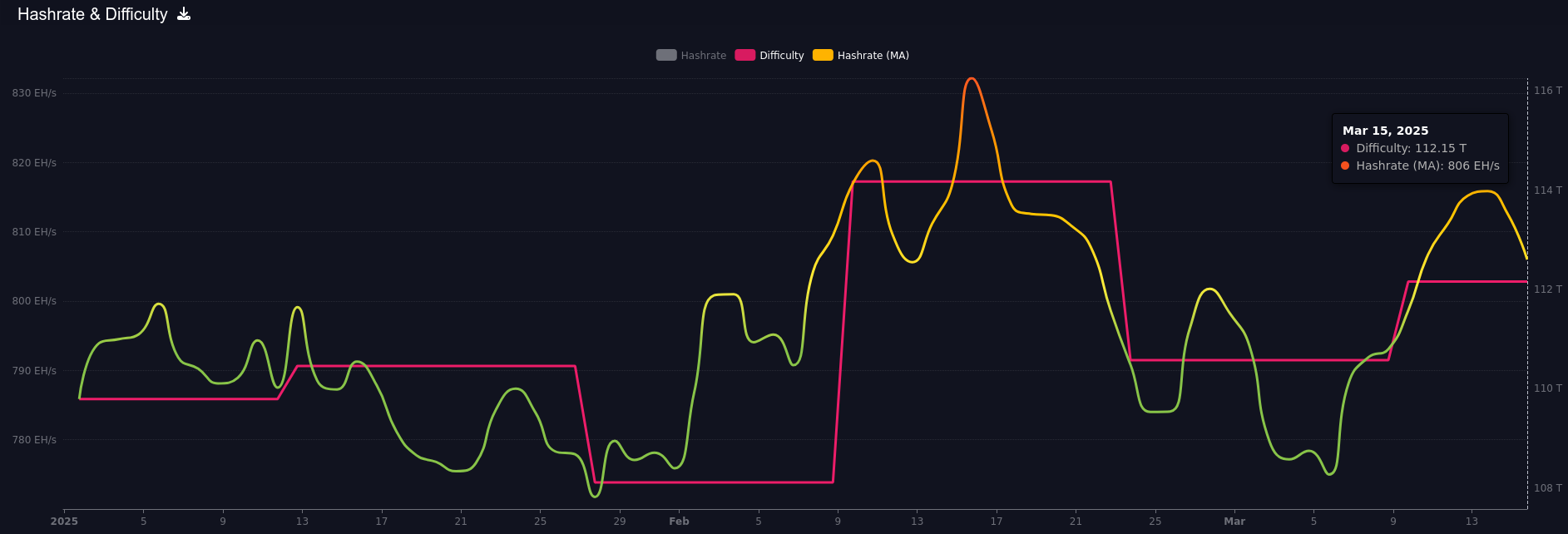 [IMG-005] 2025 hashrate/difficulty chart from mempool.space
[IMG-005] 2025 hashrate/difficulty chart from mempool.spaceDifficulty is currently 112.14T as of Epoch 440 and set to increase roughly 1.7 – 2.3% on or around March 23, 2025. But that target will change between now and then. The previous re-target increased difficulty by 1.4%. All together for 2025 thus far, difficulty has gone up ~2.15%.
New-gen miners are selling for roughly $17.65 per Th using the Bitmain Antminer S21+ 235 Th/s model from Kaboom Racks as an example. According to the Hashrate Index, more efficient miners like the <19 J/Th models are fetching $17.49 per terahash, models between 19J/Th – 25J/Th are selling for $12.68 per terahash, and models >25J/Th are selling for $3.37 per terahash.
 [IMG-006] Miner Prices from Luxor’s Hashrate Index
[IMG-006] Miner Prices from Luxor’s Hashrate IndexHashvalue is currently ~57,000 sats/Ph per day, up slightly from Frebruary when hashvalue was closer to 56,000 sats/Ph per day according to Braiins Insights. Hashprice is $47.00/Ph per day, down from $54.00/Ph per day in February.
 [IMG-007] Hashprice/Hashvalue from Braiins Insights
[IMG-007] Hashprice/Hashvalue from Braiins InsightsThe next halving will occur at block height 1,050,000 which should be in roughly 1,109 days or in other words 161,757 blocks from time of publishing this newsletter.
Conclusion:
Thank you for reading the third 256 Foundation newsletter. Keep an eye out for more newsletters on a monthly basis in your email inbox by subscribing at 256foundation.org. Or you can download .pdf versions of the newsletters from there as well. You can also find these newsletters published in article form on Nostr.
If you were looking for answers about cooling your Bitcoin miners this summer then hopefully you found them here.
If you want to continue seeing developers build free and open solutions be sure to support the Samourai Wallet developers by making a tax-deductible contribution to their legal defense fund here. The first step in ensuring a future of free and open Bitcoin development starts with freeing these developers.

The proprietary mining empire isn't going to dismantle itself; stay vigilant, frens.
-econoalchemist